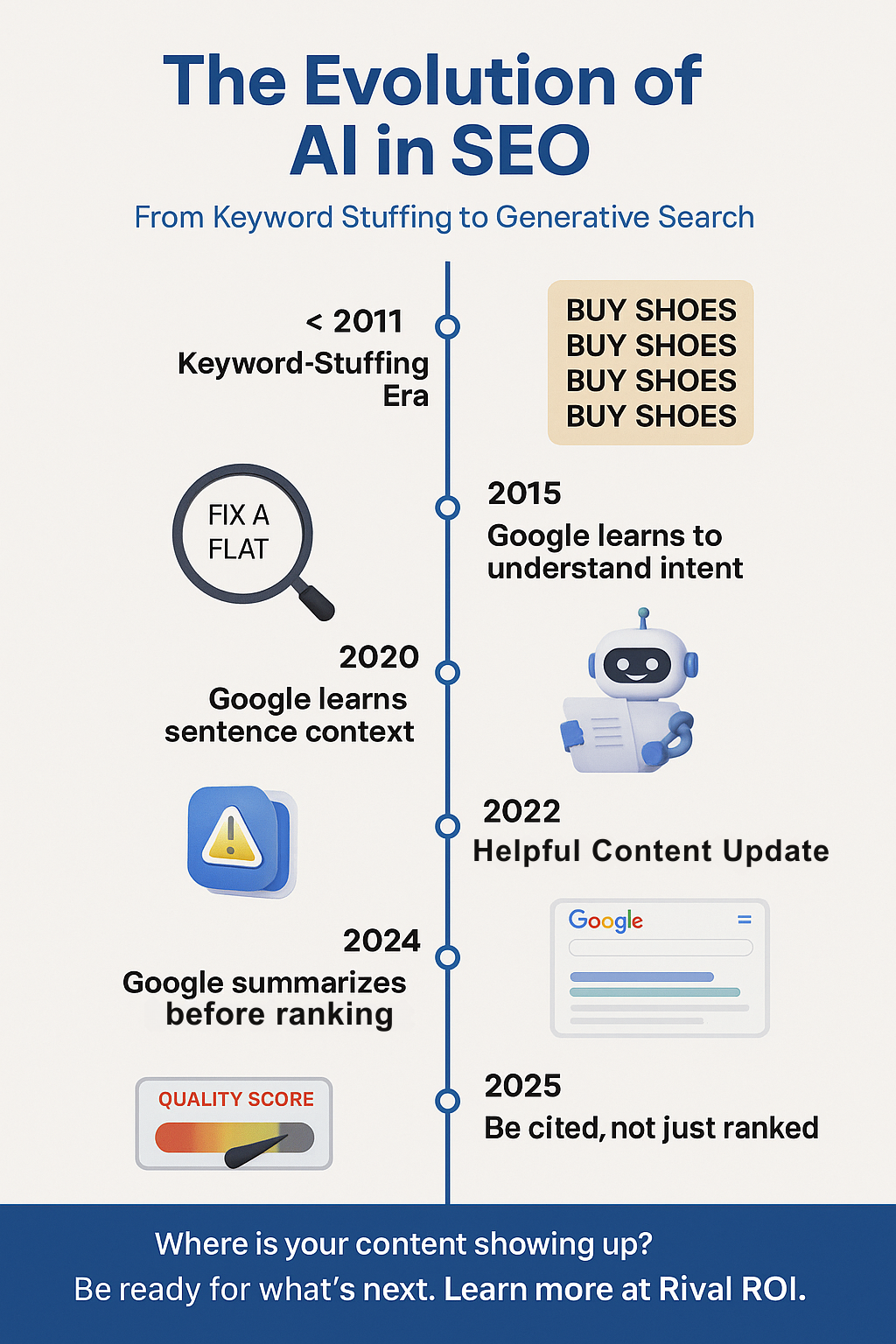
AI SEO Expert
.png)
If you've been in the marketing game for a while — or even if you’re just tuning into the buzz recently — you’ve probably felt it too:
SEO isn’t what it used to be.
We’ve gone from stuffing keywords into clunky web pages like it was a game of Tetris to building content that speaks to both humans and algorithms — and now, AI systems that think more like humans than code. What used to be a technical checklist is now a creative and strategic exercise powered by machine learning, language models, and content automation tools.
And I get it — it’s hard to keep track of all the shifts. So I’ve mapped out a timeline of how AI has reshaped SEO over the last decade. Not just the updates from Google, but how marketers (like us) have adapted, what tools changed the game, and how search itself is becoming less of a directory… and more of a conversation.
.png)
Back in the day, SEO was basically a formula:
It was like trying to win at Monopoly by owning Boardwalk and Park Place — simple, predictable, and honestly a bit easy to game if you knew the rules.
There was no real understanding of intent. If someone searched “apple,” the algorithm didn’t know if they meant the fruit, the company, or the stock ticker. Pages that repeated “best apple deals” 14 times often beat out actually useful content.
Looking back, this era was all about brute force SEO — no AI, no nuance. Just rules and loopholes.
Then came RankBrain — Google’s first real move toward machine learning in search. It launched around 2015, and it changed the game.
Now, instead of only matching keywords, Google started interpreting what you meant. If someone searched “how to fix a flat,” it didn’t just look for those exact words — it looked for related concepts, like “patching a tire” or “repairing a puncture.”
Think of it like this: RankBrain was the first time Google put on glasses and could actually see what users were trying to say, not just what they typed.
This kicked off the move from string-matching to intent-matching — and for content creators, it meant we had to stop writing for robots and start writing for humans who ask weird, messy, real-world questions.
Then came BERT in 2019 — Google's natural language model that basically helped the algorithm understand context on a sentence level.
To get technical for a second (bear with me): BERT is a deep learning model trained to understand relationships between words in a sentence. So instead of treating each word as an island, it understood meaning from context.
For example:
Search for “can you get medicine for someone pharmacy” — before BERT, Google might surface results about getting medicine from someone. Post-BERT? It knew you were talking about picking up meds on behalf of someone else.
That’s a big deal. It's like going from a phrasebook to a real-time translator who actually gets what you're trying to say.
And that shift meant we had to start thinking about SEO more like conversation design than just keyword lists.
🛠 Tools like Clearscope and MarketMuse started popping up during this time, using similar NLP models to help writers optimize for semantic relevance, not just target phrases.
This is where things got wild.
With GPT-3 and its cousins, content creation entered a new era — one where marketers could generate blog posts, ads, emails, and even product pages with just a prompt.
It was like giving a jetpack to your writing team.
Suddenly, speed and scale were no longer bottlenecks.
But here’s the thing — just because you can scale content doesn’t mean you should.
Google saw the flood coming and dropped the Helpful Content Update in 2022. The message was clear: “We know some of you are using AI. That’s fine. But the content better be good.”
So, this era wasn’t just about generating content fast — it was about training your prompts, editing for clarity, and making sure your content still had a pulse.
👀 At Rival ROI, we built a process that combines AI-generated drafts with human edits, fact-checking, and structured formatting — and we saw faster rankings, better engagement, and more backlinks as a result.
Right now, we’re in the thick of it again.
With AI Overviews and SGE (Search Generative Experience) rolling out, Google isn’t just ranking pages — it’s summarizing them. And oftentimes, it’s doing that before users even click a result.
That means traditional "position #1" doesn’t mean what it used to. Now the game is about being cited, not just being clicked.
I like to say we’ve moved from “SEO for visibility” to “SEO for inclusion.” You want to be in the AI’s source material — like a journalist quoting you in a story.
This shift is why we’ve retooled our entire process at Rival ROI:
If you're still only focused on ranking blog posts, you're playing checkers in a chess match.

We’ll stop asking “what keywords should I use?” and start asking,
“How can I train an AI to see me as the expert?”
SEO won’t just be about content anymore — it’ll be about AI context engineering.
Trust will flow through structured data, author bios, schema, and AI-recognizable signals — not just who links to you.
Think of backlinks like newspaper clippings. Still useful, just not the main currency of credibility anymore.
Expect fewer clicks, more zero-click results, and greater reliance on being cited in summaries.
Your content won’t always be read. But it better be trusted.
AI isn’t replacing SEO. It’s redefining it.
That means we need to stop chasing rankings and start designing content that’s:
At Rival ROI, we’re building SEO strategies that don’t just keep up — they leap ahead.
Let’s talk about how to evolve your SEO strategy with AI — before your competitors do.